‘A roadmap for a coup’: inside Trump’s plot to steal the presidency | US elections 2020 | The Guardian
"On 4 January, the conservative lawyer John Eastman was summoned to the Oval Office to meet Donald Trump and Vice-President Mike Pence. Within 48 hours, Joe Biden’s victory in the 2020 presidential election would formally be certified by Congress, sealing Trump’s fate and removing him from the White House.
The atmosphere in the room was tense. The then US president was “fired up” to make what amounted to a last-ditch effort to overturn the election results and snatch a second term in office in the most powerful job on Earth.
Eastman, who had a decades-long reputation as a prominent conservative law professor, had already prepared a two-page memo in which he had outlined an incendiary scenario under which Pence, presiding over the joint session of Congress that was to be convened on 6 January, effectively overrides the votes of millions of Americans in seven states that Biden had won, then “gavels President Trump as re-elected”.
The Eastman memo, first revealed by Bob Woodward and Robert Costa in their book Peril, goes on to predict “howls” of protest from Democrats. The theory was that Pence, acting as the “ultimate arbiter” of the process, would then send the matter to the House of Representatives which, following an arcane rule that says that where no candidate has reached the necessary majority each state will have one vote, also decides to turn the world upside down and hand the election to the losing candidate, Donald Trump.

Eastman’s by now notorious memo, and the surreal encounter in the Oval Office, are among the central twists in the unfolding story of Trump’s audacious bid to hang on to power. They form the basis of what critics argue was nothing less than an attempted electoral coup.
In an interview with the Guardian, Eastman explained that he had been asked to prepare the memo by one of Trump’s “legal shop”. “They said can you focus first on the theory of what happens if there are not enough electoral votes certified. So I focused on that. But I said: ‘This is not my recommendation. I will have a fuller memo to you in a week outlining all of the various scenarios.’”
Inside the Oval Office, with the countdown on to 6 January, Trump urged Pence to listen closely to Eastman. “This guy’s a really respected constitutional lawyer,” the president said, according to the book I Alone Can Fix It.
Eastman, a member of the influential rightwing Federalist Society, told the Guardian that he made clear to both men that the account he had laid out in the short memo was not his preferred option. “The advice I gave the vice-president very explicitly was that I did not think he had the authority simply to declare which electors to count” or to “simply declare Trump re-elected”.
Eastman continued: “The vice-president turned to me directly and said, ‘Do you think I have such powers?’ I said, ‘I think it’s the weaker argument.’”
Instead, Eastman pointed to one of the scenarios in the longer six-page memothat he had prepared – “war-gaming” alternatives. His favorite was that the vice-president could adjourn the joint session of Congress on 6 January and send the electoral college votes back to states that Trump claimed he had lost unfairly so their legislatures could have another go at rooting out the fraud and illegality the president had been railing about since election day.
“My advice to the vice-president was to allow the states formally to assess the impact of what they had determined were clear illegalities in the conduct of the election,” Eastman said. After a delay of a week or 10 days, if they found sufficient fraud to affect the result, they could then send Trump electors back to Congress in place of the previous Biden ones.
The election would then be overturned.
“Those votes are counted and TRUMP WINS,” Eastman wrote in his longer memo, adding brashly: “BOLD, certainly … but we’re no longer playing by Queensbury rules.”
Eastman insisted to the Guardian that he had only been presenting scenarios to the vice-president, not advice. He said that since news of his memos broke he had become the victim of a “false narrative put out there to make it look as though Pence had been asked to do something egregiously unconstitutional, so he was made to look like a white knight coming in to stop this authoritarian Trump”.
The problem is that for many close observers of American elections, Eastman’s presentation to Pence just two days before the vice-president was set to certify Biden’s victory leaves a very different impression.
Michael Waldman, president of the Brennan Center for Justice at New York University, a leading authority on US election issues, sees Eastman’s set of alternative scenarios as nothing less than a “fairly detailed roadmap for a constitutional coup d’état. That memo was a plan for a series of tricks to steal the presidency for Trump.”
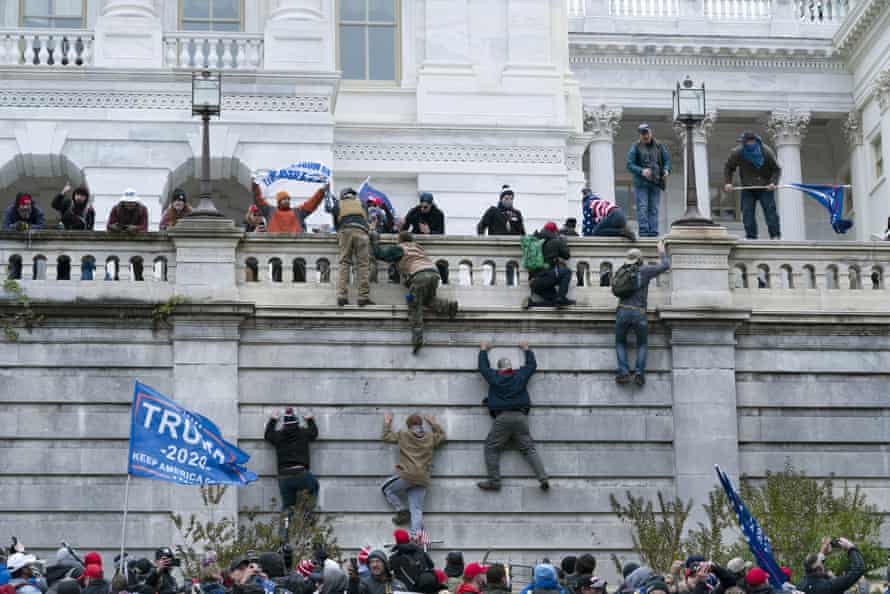
The 2020 presidential election was the largest in US history, with a record 156 million votes cast and the highest turnout of eligible voters since 1900. By all official accounts, it was also among the most secure and well-conducted in US history.
“It was something of a civil miracle,” Waldman said. “To have this massive turnout, an election that was extraordinarily well run, in the middle of a pandemic – this was one of America’s finest hours in terms of our democracy.”
And yet, Waldman went on, what happened next? “Trump’s big lie, his campaign to overturn the election, the insurrection.”
Alarm bells began to ring months before America went to the polls on 3 November 2020. As early as July Trump was laying into mail-in voting, which was seeing huge voter take-up as a result of Covid-19, deriding the upcoming poll as the “most INACCURATE & FRAUDULENT Election in history” and calling for it to be delayed.
At the time, Biden was holding a steady opinion poll lead over Trump in battleground states.
By September, Trump was refusing to commit to a peaceful transfer of power. He told reporters: “We’re going to have to see what happens.”
When we did see what happened – Biden winning the presidency by a relatively convincing margin – Trump refused to concede. Now, something that had only been posited as a remote and extreme possibility was unfolding before Americans’ eyes.
“The events of 2020 were unprecedented,” said Ned Foley, a law professor at the Ohio State University. “A sitting president was trying to get a second term that the voters didn’t want him to have – it was an effort to overturn a free election and deprive the American people of their verdict.”
Since the violent incidents of 6 January when a mob of Trump supporters stormed the US Capitol, resulting in the deaths of five people, information has begun to amass about Trump’s extensive ploy to undo American democracy. Congressional investigations by the US House and Senate have added granular detail that has astonished even seasoned election-watchers in terms of the scale and complexity of the endeavour.
For Foley, a picture has come into focus of a “systematic effort to deny the voters their democratic choice. It was a deliberate, orchestrated campaign, and there’s nothing more fundamentally undemocratic than what was attempted.”
Rick Hasen, a law professor at the University of California, Irvine who has written a report on 2020 election subversion, said that as time has passed the scope of Trump’s ambition has become clear. “There was much more behind the scenes than we knew about. We came much closer to a political and constitutional crisis than we realized,” he said.
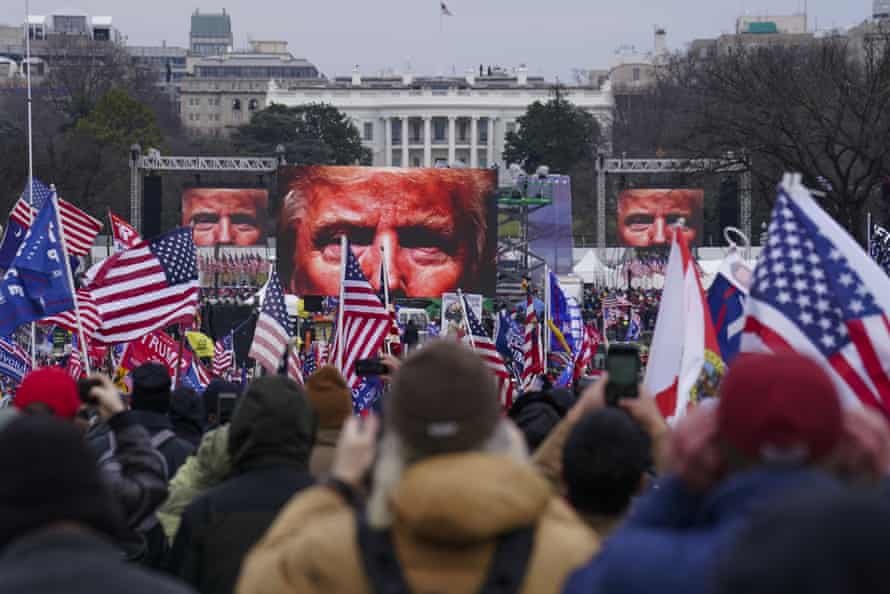
In his Guardian interview, Eastman justified his Oval Office presentation to Pence on scenarios of how to overturn an election by pointing to widespread irregularities in the 2020 voting process. He claimed there were “violations of election law by state or county election officials” and “good, unrebutted evidence of fraud”.
Asked how he would answer the charge that has been levelled at him that he had sketched out an electoral coup, he replied: “That begs the question: was there illegality and fraud? If there was, and it altered the results of the election, then that undermines democracy, as we have someone put in office who has not been elected.”
But why would such widespread fraudulent activity be directed against Trump and not, say, Biden, or before him Barack Obama? Eastman said that it was because Trump was “pushing back against the deep state in American politics”.
The “deep state” had become such an entrenched bureaucracy that it was “unaccountable to the ultimate sovereign authority of the American people”, Eastman said. “Trump’s punching back had all of the forces aligned with that entrenched bureaucracy doing everything to stop him.”
.
Contrary to Eastman’s claim that widespread fraud occurred during the election, all the main federal and state authorities charged with safeguarding the 2020 election, including law enforcement, have declared it historically secure. In several instances, that conclusion was reached by Trump’s own hand-picked Republican officials.
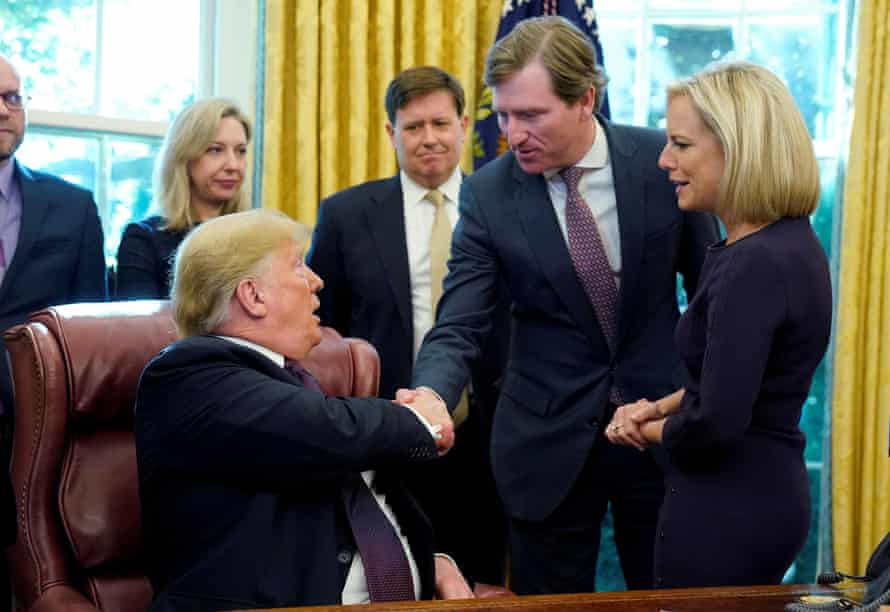
They included Chris Krebs, who had been appointed by Trump to be director of the US Cybersecurity and Infrastructure Security Agency (Cisa) in charge of protecting the integrity of the 2020 election. On 12 November, Cisa put out a joint statement from election security officials that found the presidential vote to be “the most secure in American history”.
Five days later Krebs was out of a job. “He fired me by Twitter,” Krebs told the Guardian. “One of Trump’s own nominees saying the election was legitimate was a credibility issue for him. What he did to me shows there were lengths to which the former president would go which were well beyond any previous norms.”
Bill Barr, then US attorney general, was another Trump appointee who challenged the false claims of mass election fraud. Two days after the election, Barr bowed to pressure from the president and allowed federal prosecutors to investigate allegations of voting irregularities, a break with a longstanding justice department norm that prevented prosecutors from interfering in active election counts.
Yet later in November, Barr met Trump at the White House and told him bluntly, according to Peril, that stories of widespread illegality were “just bullshit”. Then, on 1 December, the attorney general told Associated Press that the FBI and prosecutors had found no fraud on a scale sufficient to impact the election result.
Barr stood down as the nation’s top prosecutor two weeks later.
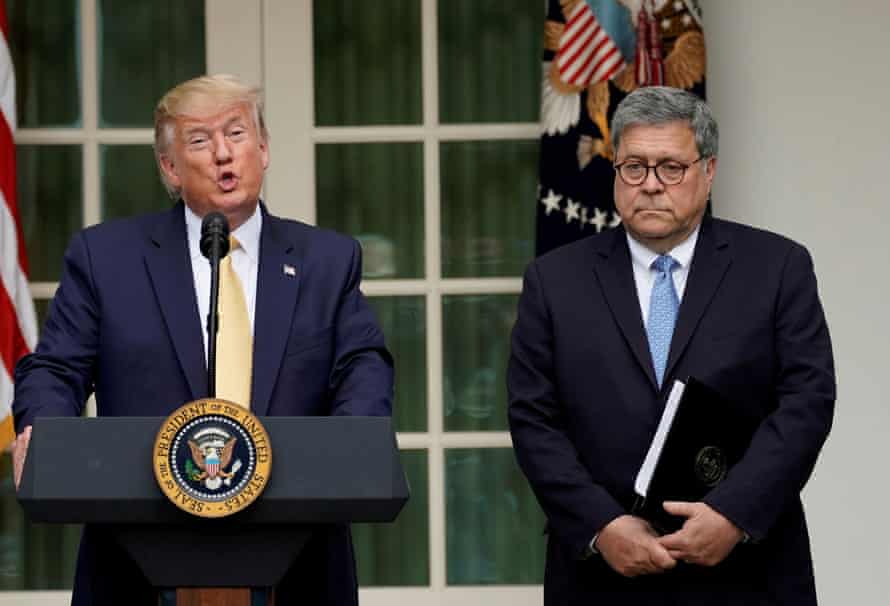
Another prominent Republican lawyer who thoroughly rejects Trump’s “big lie” that the election was stolen from him is Ben Ginsberg. For almost four decades, Ginsberg was at the center of major election legal battles as counsel to the Republican National Committee as well as to four of the last six Republican presidential nominees, through his law firm, Trump included.
Ginsberg was also a central figure in the white-hot recount in Florida in 2000 that handed the White House to George W Bush.
“What we’ve seen has been different from anything in my experience, because Donald Trump has made an assertion about our elections being fraudulent and the results rigged,” Ginsberg told the Guardian. “I know from my 38 years of conducting election-day operations that that simply is not true, there is no evidence for it. What Donald Trump is saying is destructive to the democracy at its very foundations.”
Ginsberg likened Trump to an arsonist firefighter. “He is setting a fire deliberately so that he can be the hero to put it out. The problem is that there is no real fire, there is no systemic election fraud. The destruction is unnecessary.”
Trump’s campaign to subvert the election began with a flurry of tweetsafter election day. The New York Times calculated that in the three weeks from 3 November he attacked the legitimacy of the election to his vast social media following more than 400 times.
In the past few weeks, as congressional investigations have deepened, it has become clear that Trump’s efforts to overturn the election result were much more extensive and multi-layered than his Twitter rages. “This wasn’t just some crazy tweets,” Waldman said. “There was a concerted effort to push at every level to find ways to cling to power, even though he had lost.”
Politico estimated that in the month after the election, the sitting president reached out to at least 31 Republicans at all levels of government, from governors to state lawmakers, members of Congress to local election officials. Such was the obsessive attention to detail, the sitting US president even called the Republican chairwoman of the board of canvassers in Wayne county, Michigan, to encourage her not to certify Biden’s victory in a heavily Democratic area.
At the centre of the operation was a ragtag bunch of lawyers assembled by Rudy Giuliani, the former mayor of New York who was acting as Trump’s personal attorney. Few of the team had experience in election law; Barr referred to them, according to Peril, as a “clown car”.
Among the comical conspiracy theories amplified by Giuliani and the Trump campaign lawyer Sidney Powell was “Italygate”, the idea that an Italian defense company used satellites to flip votes from Trump to Biden.
Such florid fantasies, and the accompanying absence of hard and credible data, did little to endear Trump’s legal team to the courts. By the end of December, 61 lawsuits had been lodged by Trump and his acolytes in courts ranging from local jurisdictions right up to the US supreme court. Of those, only one succeeded, on a minor technicality.
Yet the epic failure to persuade judges to play along with Trump’s efforts at subversion should not disguise the seriousness of the endeavour, nor how far it was allowed to proceed. “What I find most disturbing is how far this plot got with such thin material to work with,” Foley said.
One of the most alarming aspects of the fraud conspiracy theories peddled around Trump was that so many senior Republicans and the Republican party itself endorsed them.
On 19 November, Powell was invited to appear in front of cameras at the headquarters of the Republican National Committee. Four days earlier, the Trump campaign had circulated an internal memo that thoroughly debunked a bizarre claim championed by Powell – that Biden’s victory was the product of a communist plot. Yet Powell went ahead nonetheless, using her RNC platform to double down on the palpably false claim that Dominion voting machines created by Venezuela’s deceased president Hugo Chávez (they weren’t) had been manipulated to redirect Trump votes to Biden (they hadn’t).
Complicity in the lie of the stolen election reached right to the heart of the Republican party. Even on 6 January, while shattered glass lay strewn across the corridors of Congress following the violent insurrection hours earlier, 139 House Republicans – more than half the total in the chamber – and eight Senate Republicans went ahead and voted to block the certification of Biden’s win.
Many other Republicans also acted as passive accomplices in Trump’s subversion plot, by failing publicly to speak out against it. Mitch McConnell, the top Republican in the US Senate, waited until 15 December to recognize Biden as president-elect.
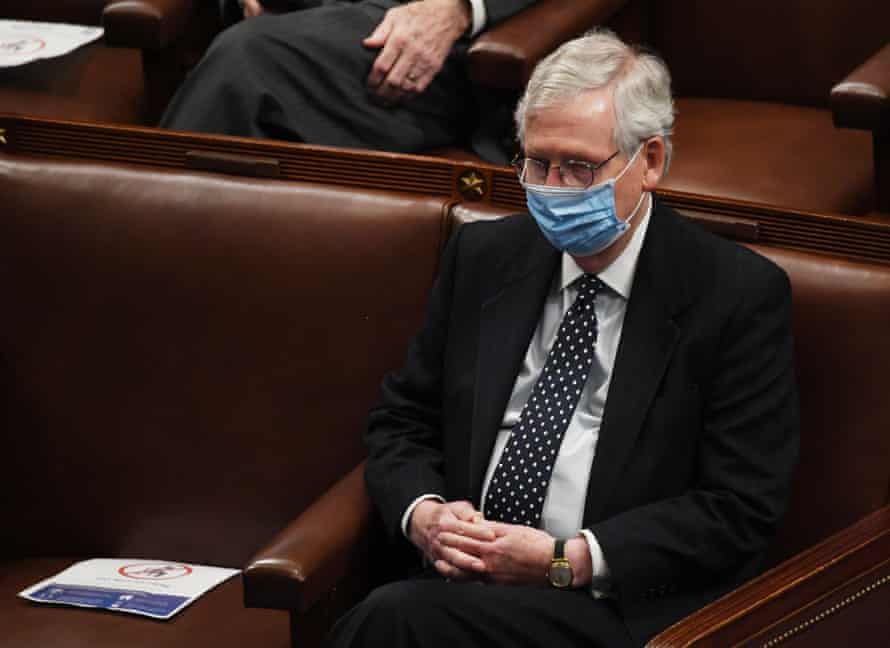
For six weeks, McConnell watched and waited. He remained silent, as every day the big lie grew stronger, amplified through the echo chambers of Fox News, the far-right OANN news network and a web of Trump benefactors including the MyPillow founder, Mike Lindell.
Ginsberg told the Guardian that “the greatest disappointment to me personally is seeing people I know to be principled, with only the best intentions for the country, stand aside as Donald Trump wreaks havoc through American democracy. I don’t understand that, and I think it has really negative ramifications.”
Ginsberg added: “Many of them are guilt-ridden about that. It is a very unfortunate, disappointing situation.”
On 7 November, the Associated Press called Pennsylvania, and with it the presidency, for Biden. At that point, Trump’s efforts to subvert the election went into hyper-drive.
“Trump appeared to think he had a viable path to staying in power,” said Hasen. “His outlook morphed into an actual attempt to use the claims of fraud to try and overturn the election.”
Trump turned to what has been dubbed the “independent state legislature doctrine”. This is a convoluted legal theory that has been increasingly embraced by the right wing of the Republican party.
Those who adhere to the doctrine point to the section of the US constitution that gives state legislatures the power to set election rules and to determine the “manner” in which presidential electors are chosen under the electoral college system. If those rules are changed by other legal entities without the approval of the state legislatures, then, the theory goes, election counts can be deemed illegitimate and an alternate slate of electors imposed.
“It’s an extreme legal theory that does not depend on fraud but on claimed irregularities between the way 2020 was conducted and how the states had set up the election,” Hasen said.
Trump and his legal advisers began bearing down on critical swing states which Biden had won, attempting to browbeat state legislators into taking up the doctrine and using it as a means of overturning the result. Lawmakers in Arizona, Pennsylvania and other battleground states were encouraged to call a special session to highlight the disparities in election procedures, with the end goal being to replace Biden’s presidential electors with an alternate slate of Trump electors.
In his Guardian interview, Eastman said he was part of this effort. “I recommended that the legislatures be called into special session to assess the impact of the illegality. If there were cumulative illegal actions greater than the margin of victory, then the legislature needed to take the power back.”
A month before Eastman gave his presentation to Trump and Pence in the Oval Office, he appeared before the Georgia legislature. By that point Georgia had already held a full hand recount of the almost 5m votes cast and was poised to announce the results of a third count – all of which confirmed Biden had won.
In a half-hour presentation on 3 December, Eastman called on Georgia’s lawmakers to effectively take the law into their own hands. “You could adopt a slate of electors yourselves,” he told them. “I don’t think it’s just your authority to do that, but, quite frankly, I think you have a duty to do that to protect the integrity of the election in Georgia.”
And then Trump took the fight to the next level: into the heart of US law enforcement. An interim report from the Senate judiciary committee published earlier this month chronicles the bombardment to which senior Department of Justice officials were subjected in the days leading up to 6 January.
It is a fundamental DoJ norm that the president and his allies should never interfere in any investigation, let alone to undermine American democracy. Yet the Senate report shows that on the day after Barr’s departure was announced, 15 December, Trump began ratcheting up pressure on his replacement to try to get him to adopt the big lie.
When Jeffrey Rosen, the new acting attorney general, demurred, Trump turned to a relatively lowly justice official, Jeffrey Clark, and propelled him into the thick of a mounting power struggle that had the potential to turn into a full-blown constitutional crisis. Clark, who was recently subpoenaed by the House committee investigating the 6 January insurrection, drew up a draft letter which he intended to have sent out to six critical swing states.
In essence, it called on state legislatures won by Biden to throw out the official will of the people and reverse it for Trump.
When Rosen refused to authorize the letter, Trump prepared to fire him and put Clark in his place. It took a showdown in the Oval Office at which key justice department officials threatened to resign en masse, accompanied even by the White House counsel, Pat Cipollone, before Trump stood his threat down.
That volatile three-hour meeting on 3 January was one of the most dramatic incidents in which US democracy was pushed to the brink of collapse. It was not the only one.
As the clock ticked down towards Trump’s final appointment with fate on 6 January, he grew more and more agitated. On 27 December, he called Rosen to make another attempt at cajoling the justice department to come on board with his subversion plot.
Handwritten notes taken by Rosen’s deputy record an astonishing exchange:
Rosen: “Understand that the DoJ can’t + won’t snap its fingers + change the outcome of the election, doesn’t work that way.”
Trump: “Don’t expect you to do that, just say that the election was corrupt + leave the rest to me and the R[epublican] congressmen.”
Then, on 2 January, Trump made his by now notorious call to Brad Raffensperger, Georgia’s top election official as secretary of state. A recording of the conversation obtained by the Washington Post captured Trump telling Raffensperger, “I just want to find 11,780 votes” – one more vote than Biden’s margin of victory in the official count.

Raffensperger politely rejected the request. Four days later, Pence turned his back on Eastman’s scenarios, and announced that he would do his constitutional duty and certify Biden as the 46th president of the United States.
Trump had run out of road. He had nothing left, nowhere else to turn. Nothing, that is, except for his adoring, credulous and increasingly angry supporters.
“Big protest in DC on January 6th. Be there, will be wild!” Trump exhorted his followers in a now excised tweet.
Just how direct was Trump’s involvement in inciting the insurrection is now the stuff of a House select committee inquiry. The committee is aggressively pursuing Steve Bannon, Trump’s former chief strategist in the White House, over any role he might have played in the buildup towards the violence.
Bannon, who faces criminal charges for defying congressional subpoenas, was among a gathering at the Willard Hotel in Washington on the eve of 6 January that the House committee has dubbed the “war room”. Also present were Giuliani and Eastman. According to Peril, Trump called into the meeting and spoke with Bannon, expressing his disgust over Pence’s refusal to play along and block the certification just as Eastman had outlined.
When 6 January finally arrived, all eyes were on the Ellipse, the park flanking the White House where Trump was set to headline a massive “Stop the Steal” rally. Before he spoke, Eastman said a few words.
The law professor recounted one of his more lurid conspiracy theories – that voting machines had secret compartments built within them where pristine ballots were held until they were needed to increase Biden’s numbers and put him over the top. “They unload the ballots and match them to the unvoted voter and … voilà!”
Then Trump took the stage. He encouraged his thousands of followers to march to the Capitol. “Fight like hell. If you don’t fight like hell, you’re not going to have a country any more.”
The Guardian asked Eastman whether he had any regrets about what happened, personal or otherwise. A week after the insurrection he was pressured into stepping down from his post at Chapman University in California.
“Regrets, yes, that people are taking action against me for telling the truth,” he said. “Regrets that I told the truth and that I continue to do so? Absolutely not.”
Eastman’s pledge to continue “telling the truth” will not soothe the anxieties of those concerned about American democracy. Already, speculation about another Trump run in 2024 is causing jitters.
Liz Cheney, a member of the House committee inquiry into the insurrection, has issued a stark warning to her Republican colleagues. Unless they start really telling the truth, she has told them, and countering the lies about election fraud, the country is on the path of “national self-destruction”.
Rick Hasen shares her fears. “Donald Trump has been underestimated before,” he said. “He is telling us he’s planning on running. He’s continuing to claim the election was stolen. The situation in the United States right now is desperate.”
No comments:
Post a Comment